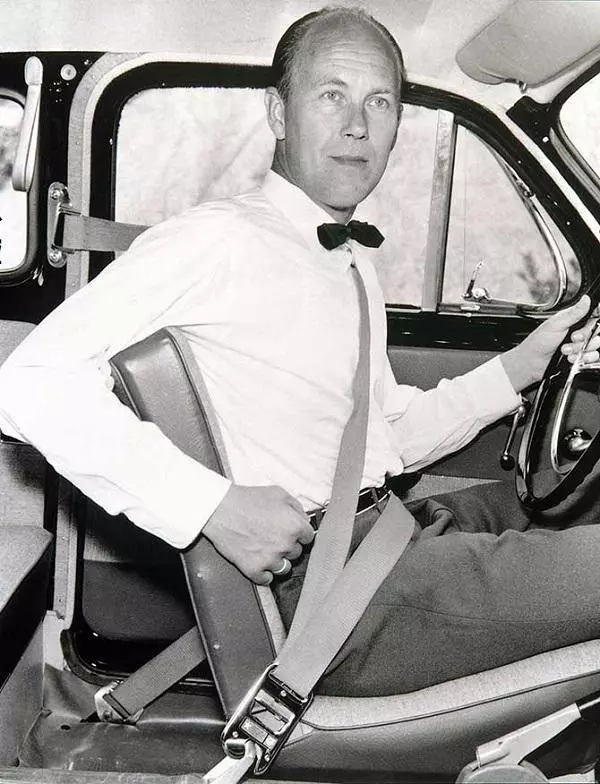
Nils Bohlin invented the three-point seat belt in 1959. There is no way of working out how many people his invention has saved, but it must be over a million, at least. The US National Highway Traffic Safety Administration thinks that the three-point seatbelt saves about 15,000 lives a year in the US alone. Bohlin worked for Volvo at the time. The invention was incredible, but the most impressive thing Nils Bohlin and Volvo did was to leave the patent open so other companies could use the design for free. They could have made a fortune, but the safety of drivers was more important to them.
When cars were first invented they didn’t have any safety belts. Most people who rode in a car for the first time were used to riding horses or in horses and carts and they don’t use seatbelts, or, if they did, it was a piece of rope. In fact, the first seatbelt was invented for a glider and not a car. George Cayley was making gliders in the mid 19th century and he made a seatbelt so that he wouldn’t fall out of the glider. It always fascinates me that things we take for granted had a starting point.
Cars started to become more popular after World War 1 and they started to get faster as well. The number of fatal accidents rose in line. In the early 1900s, the first seatbelt for a car was introduced, but it was more like a climbing harness. Some drivers would make their own seatbelts. A strap seatbelt was introduced into cars from 1949, but they were always optional and most people didn’t want one. In 1955, only 2% of Ford buyers chose to have a seatbelt. These seatbelts were more designed to stop the people falling out of the car than to save them in an accident. Then, in the 1950s, Hunter Sheldon, a neurologist, realized there were a high number of head injuries coming into the emergency room and most of them were caused by these primitive seatbelts. The driver would be in an accident, the car would stop suddenly, the driver would fly forward but be stopped by the seatbelt around their waist, and their head would hit the dashboard and steering wheel, which were all made of wood. He recommended a retractable seatbelt. A lot of his ideas were listened to and safety standards for cars were introduced in the 1960s.
Nils Bohlin was born in Sweden in 1920. He studied mechanical engineering and then found a job for the aircraft company Saab. He was an aircraft designer and particularly involved in the design of ejection seats. In 1958, he moved to Volvo as a safety engineer. He was tasked with making the seatbelt safer. He had done a lot of studies on seatbelts while he was designing ejector seats and that knowledge came in handy. He looked at the problem in a different way and tried to work out what configuration would keep the driver and passengers safest, rather than just in the car. They obviously have to be kept in their seat, but they need chest support to keep their heads away from the dashboard. They also need seatbelts that contract to keep the person in the seat, but not so much that they cause injury. He came up with the three-point seatbelt that we still use today.
Bohlin and Volvo proved the effectiveness of his seatbelt with data. He looked at 28,000 car accidents in Sweden. In crashes that happened at speeds below 100 km/h, no person who was wearing a seatbelt was killed, while almost all of the people who weren’t wearing seatbelts were killed. Wearing a seatbelt reduces the risk of fatal injury by 45% and reduced the risk of moderate to critical injury by 50%.
Nils Bohlin and Volvo realized the value of what they had created. Bohlin received the patent for the three-point seatbelt and he immediately opened it up so that other companies could use the design. He knew that the lives that would be saved were far more important than any money he could make.
Unfortunately, even though the car industry could see how much safer the three-point seatbelt could make cars, people in general didn’t agree and the large majority of people still didn’t wear seatbelts. They either thought they would make no difference or though, as most people still seem to, that they were above average drivers and didn’t need them. Governments started to crack down in the 1980s and seatbelts were made compulsory. The police began to enforce the law and the number of deaths from road traffic accidents dropped significantly. Many people still don’t see the necessity of a seatbelt and even in 2024 a lot of people don’t wear them. They believe that their airbags will save them. Airbags are designed to work with seatbelts, though, and if you crash without a seatbelt, your face will meet the rapidly expanding airbag, which will most likely kill you.
The three-point seatbelt was also responsible for another interesting phenomena called risk compensation. ABS brakes, airbags, and many other safety features have also caused this. People feel that when they wear seatbelts, they are safter, and so they drive faster than they ordinarily would.
Nils Bohlin’s invention has saved millions of people’s lives without them even knowing it and very few people have ever heard of him. And this is what I learned today.
Image https://www.media.volvocars.com/global/en-gb/media/photos/6486
Sources
https://en.wikipedia.org/wiki/Nils_Bohlin
https://en.wikipedia.org/wiki/Seat_belt#Three-point
https://www.sae.org/publications/technical-papers/content/670925/
https://www.caranddriver.com/news/a28775593/three-point-seatbelt-history/
https://science.howstuffworks.com/transport/flight/modern/ejection-seat.htm
https://www.bbc.com/news/uk-45675928
https://en.wikipedia.org/wiki/Risk_compensation
